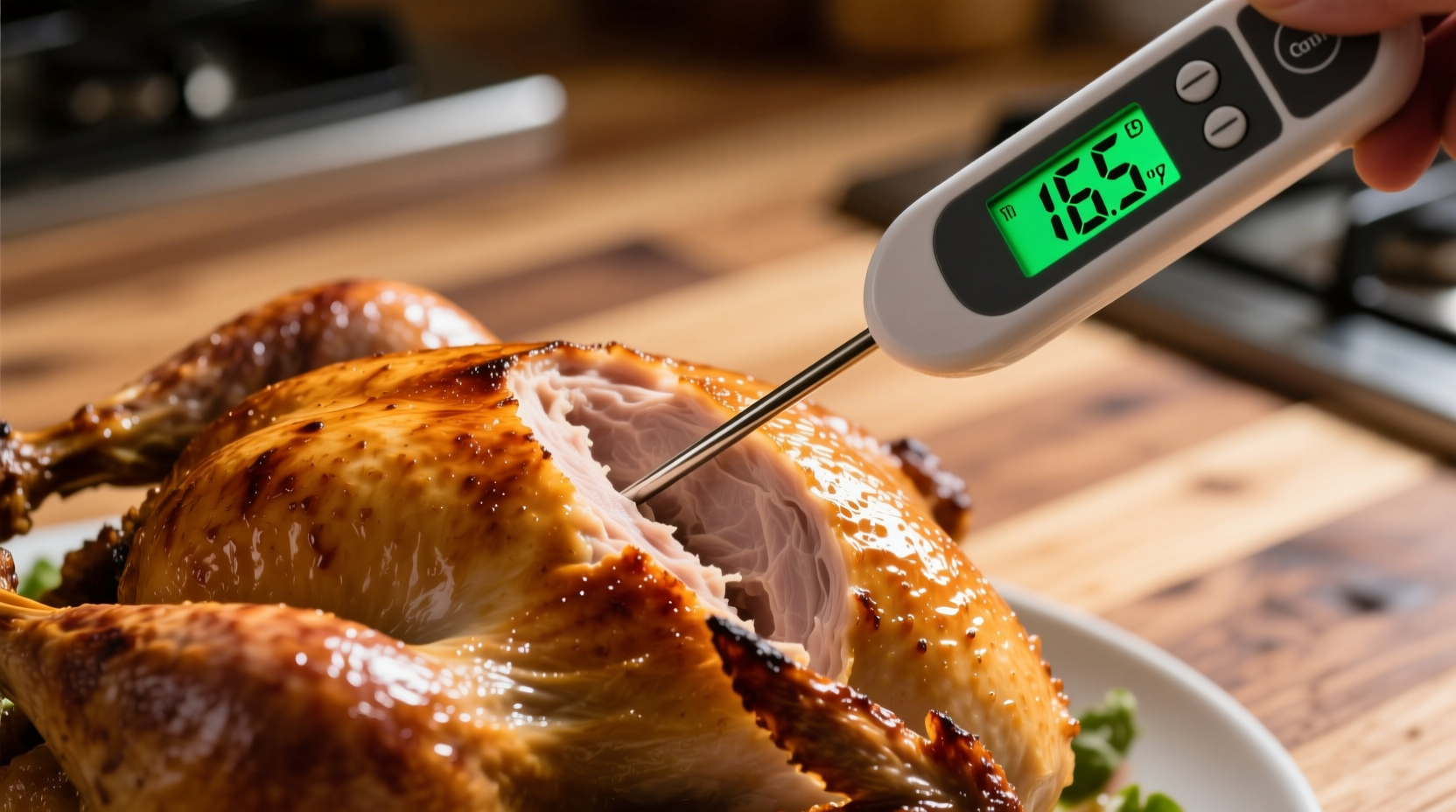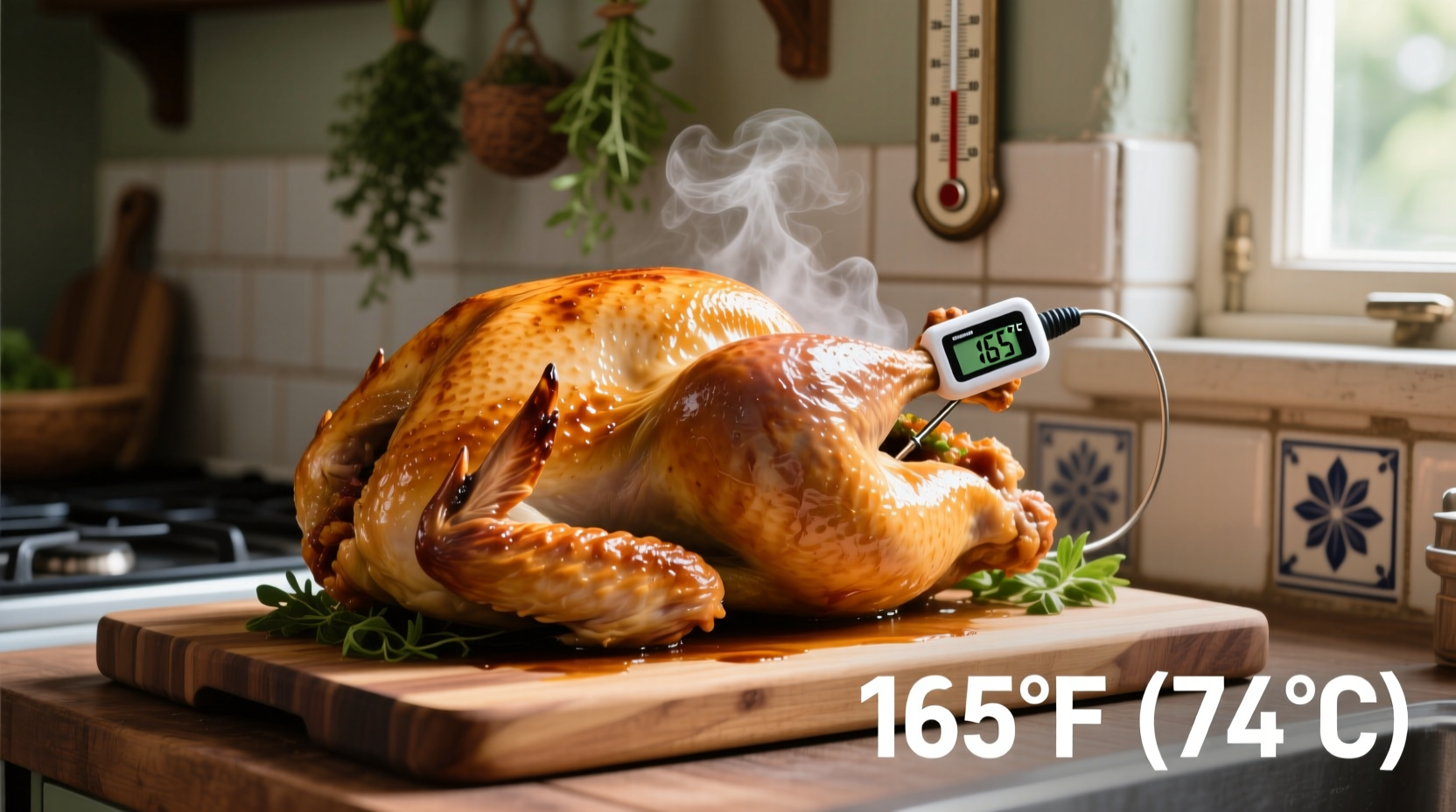The safe internal temperature for cooked turkey is 165°F (73.8°C) as measured with a food thermometer in the thickest part of the breast and thigh. This temperature destroys harmful bacteria like salmonella and campylobacter that can cause foodborne illness.
When preparing your holiday centerpiece, knowing exactly what temperature to cook turkey to isn't just about perfection—it's a critical food safety requirement. Undercooked turkey ranks among the top causes of Thanksgiving food poisoning, with the CDC reporting over 1 million annual cases of salmonella from poultry. As someone who's cooked hundreds of turkeys in both professional kitchens and home settings, I've seen how easily temperature mistakes happen when cooks rely on guesswork instead of thermometers.
Why 165°F Is Non-Negotiable for Turkey Safety
The USDA's Food Safety and Inspection Service mandates 165°F internal temperature for all poultry products based on extensive research into pathogen destruction. At this precise temperature, dangerous bacteria like salmonella and campylobacter—which commonly contaminate raw turkey—are eliminated within seconds. Lower temperatures simply don't provide the necessary safety margin.
| Temperature | Bacterial Destruction Rate | Food Safety Status |
|---|---|---|
| 150°F (65.5°C) | Requires 2.8 minutes to destroy salmonella | Risky - uneven cooking likely |
| 155°F (68.3°C) | Requires 50 seconds | Marginally safe with perfect conditions |
| 160°F (71.1°C) | Requires 15 seconds | Acceptable for immediate consumption |
| 165°F (73.8°C) | Instantaneous destruction | USDA mandated safety standard |
This data from the USDA Food Safety Inspection Service shows why 165°F is the only temperature that guarantees safety without requiring precise timing. The margin for error at lower temperatures makes them impractical for home cooking where heat distribution varies.
Where and How to Check Your Turkey's Temperature
Proper temperature measurement technique matters as much as the number itself. Here's the professional approach:
- Use the right thermometer - Digital instant-read thermometers (like ThermoPro or Thermapen) provide accuracy within ±0.5°F. Avoid dial thermometers which often have ±2-4°F variance.
- Measure in multiple critical zones:
- Chest meat - Insert probe into thickest part of breast, avoiding bone
- Thigh - Between drumstick and body, parallel to surface
- Wings - If stuffed, check center of stuffing
- Wait for stabilization - Hold thermometer steady for 10-15 seconds until reading stops changing
- Check multiple spots - Ovens have hot/cold zones; verify temperature in several locations

Temperature Progression: What to Expect During Cooking
Understanding how turkey temperature changes during cooking prevents premature removal from the oven. The National Turkey Federation's cooking timeline shows:
- 30-40 minutes: Temperature rises quickly from refrigerator cold (40°F) to 100°F
- 1-2 hours: Enters the "stall" phase (100-120°F) where evaporation cools surface
- 2-3 hours: Rapid temperature increase through 120-150°F range
- Final 30 minutes: Critical phase from 150°F to 165°F where safety is achieved
Remember that turkey continues cooking during resting—known as carryover cooking. Remove your bird at 160-162°F to reach the target 165°F after 20-30 minutes of resting. This prevents overcooking while ensuring safety.
Troubleshooting Common Temperature Problems
Even experienced cooks encounter temperature issues. Here's how to handle them:
Turkey Reaches 165°F Too Early
If your turkey hits temperature before skin browns properly, tent loosely with foil and reduce oven temperature by 25°F. Continue monitoring—don't remove from heat until skin reaches your desired color.
Turkey Stalls Below 165°F
When turkey remains stuck between 140-155°F:
- Verify oven temperature with separate oven thermometer
- Check for uneven heating—rotate pan 180 degrees
- Consider spatchcocking (removing backbone) for faster, more even cooking
- Use a convection setting if available to improve heat circulation
Special Considerations for Different Cooking Methods
The 165°F standard applies universally, but measurement techniques vary by cooking method:
| Cooking Method | Temperature Verification Tips | Special Considerations |
|---|---|---|
| Conventional Oven | Check every 30 minutes after 2 hours | Rotate pan halfway through cooking |
| Convection Oven | Monitor more frequently (every 20 minutes) | Reduce temperature by 25°F from recipe |
| Smoker/Grill | Use wireless probe thermometer | Watch for temperature fluctuations in outdoor cooking |
| Deep-Fried | Check immediately after removal from oil | Oil temperature must stay at 350°F for safety |
For stuffed turkeys, the USDA requires 165°F in both the bird AND the stuffing center. Many food safety experts actually recommend cooking stuffing separately because it takes significantly longer to reach safe temperatures inside the turkey cavity.
Why Guesswork Fails: The Danger Zone Reality
The FDA defines the "danger zone" as temperatures between 40°F and 140°F where bacteria multiply rapidly. A turkey that spends too long in this range—whether during thawing, preparation, or slow cooking—creates dangerous conditions even if it eventually reaches 165°F.
According to CDC data, improperly cooked poultry causes approximately 1 million foodborne illnesses annually in the United States. The most common mistake? Relying on visual cues like clear juices or skin color instead of thermometer verification.
Professional Tips for Temperature Success
- Calibrate your thermometer annually by testing in ice water (should read 32°F) or boiling water (212°F at sea level)
- Insert thermometers early in cooking for continuous monitoring with oven-safe probes
- Let turkey rest 20-30 minutes after reaching 165°F—this allows juices to redistribute without further cooking
- Sanitize thermometer probes between measurements to prevent cross-contamination
Remember that food safety standards exist because people have gotten seriously ill from undercooked poultry. When cooking for vulnerable populations—children, elderly, or immunocompromised individuals—the 165°F standard becomes even more critical.
Can turkey be safe at 160°F if held there for several minutes?
While salmonella begins dying at 150°F, the USDA requires 165°F for immediate safety without precise timing. At 160°F, you'd need to maintain that temperature for at least 15 seconds to achieve equivalent safety, which is difficult to verify in home cooking conditions.
Why does my turkey thermometer show different readings in different spots?
Oven hot spots, bone proximity, and varying meat thickness cause temperature variations. Always check multiple locations—the thickest parts of breast and thigh—and use the lowest reading as your guide. Digital thermometers with thin probes provide more precise spot measurements.
Should I measure temperature before or after resting?
Check temperature immediately before removing from oven. Turkey continues cooking during resting (carryover cooking), typically rising 5-10°F. Remove at 160-162°F to reach 165°F after 20-30 minutes of resting, which prevents overcooking while ensuring safety.
Is 165°F the same for smoked or grilled turkey?
Yes, the 165°F safety standard applies to all cooking methods. However, smoking or grilling often involves lower temperatures for longer periods, making continuous monitoring with a wireless probe thermometer essential to verify when safety temperature is reached.
What's the risk if my turkey only reaches 160°F?
At 160°F, salmonella requires about 15 seconds to be destroyed. If the temperature isn't held consistently, some bacteria may survive. The USDA sets 165°F as the instantaneous kill temperature to eliminate timing variables, providing the safest margin for home cooks who can't precisely control holding time.











 浙公网安备
33010002000092号
浙公网安备
33010002000092号 浙B2-20120091-4
浙B2-20120091-4